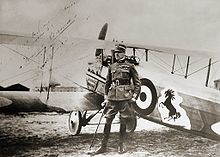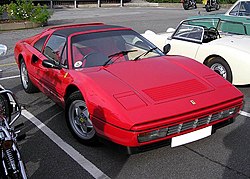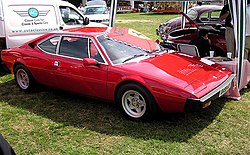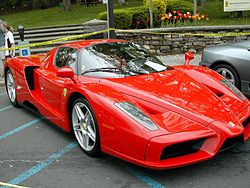Ferrari: Difference between revisions
| [pending revision] | [pending revision] |
No edit summary |
|||
| Line 415: | Line 415: | ||
* [http://www.ustifosi.com Ferrari Formula One Fan Site] |
* [http://www.ustifosi.com Ferrari Formula One Fan Site] |
||
* [http://ferrari-chat.blogspot.com Ferrari Chat] |
* [http://ferrari-chat.blogspot.com Ferrari Chat] |
||
* [http://www.automoblog.net/2006/12/05/2010-ferrari-420-dino-finally-confirmed/ Future Ferrari: 240 Dino Concept] |
|||
;Image galleries |
;Image galleries |
||
Revision as of 04:58, 16 December 2006
- This article is about the automobile manufacturer. For other meanings, see Ferrari (disambiguation)
| File:Ferrari-Logo.svg | |
| Company type | Subsidiary of Fiat |
|---|---|
| ISIN | NL0011585146 |
| Founded | 1929 |
| Headquarters | Modena , Italy |
| Parent | Ferrari N.V. |
Ferrari is an Italian sports car manufacturer based in Maranello, Italy. Founded by Enzo Ferrari in 1929 as Scuderia Ferrari, the company sponsored drivers and manufactured race cars before moving into production of street legal vehicles in 1946 as Ferrari S.p.A.. Throughout its history, the company has been noted for its continued participation in racing, especially in Formula One, where it has largely enjoyed great success, especially during the 1950s, 1960s, 1970s, late 1990s, and 2000s.
After years of financial struggles, Enzo Ferrari sold the company's sports car division to the Fiat group in 1969 in order to help ensure continued financial backing for the foreseeable future. Enzo Ferrari himself retained control of the racing division until his death in 1988 at the age of 90.
History
1929–1946
Enzo Ferrari never intended to produce road cars when he formed Scuderia Ferrari in 1929 as a sponsor for amateur drivers headquartered in Modena. Ferrari prepared and successfully raced various drivers in Alfa Romeo cars until 1938, when he was officially hired by Alfa as head of their racing department.
In 1940, Alfa Romeo was absorbed by the government as part of the war effort. Enzo Ferrari's division was small enough to be unaffected by this. Because he was prohibited by contract from racing for four years, the Scuderia briefly became Auto Avio Costruzioni Ferrari, which ostensibly produced machine tools and aircraft accessories. Also known as SEFAC (Scuderia Enzo Ferrari Auto Corse) Ferrari did in fact produce one racecar, the Tipo 815, in the non-competition period; it was thus the first actual Ferrari car (it debuted at the 1940 Mille Miglia), but due to World War II it saw little competition. In 1943 the Ferrari factory moved to Maranello, where it has remained ever since. The factory was bombed in 1944 and rebuilt in 1946 to include a works for road car production. Right up to Il Commendatore's death, this would remain little more than a source of funding for his first love, racing.
"Scuderia Ferrari" literally means "Ferrari Stable"; the name is figuratively translated as "Team Ferrari". (It is correctly pronounced "skoo deh REE ah".)
1945–present
The first Ferrari road car was the 1947 125 S, powered by a 1.5 L V12 engine; Enzo reluctantly built and sold his automobiles to fund the Scuderia. While his beautiful and blazingly fast cars quickly gained a reputation for excellence, Enzo maintained a famous distaste for his customers, most of whom he felt were buying his cars for the prestige and not the performance. However, at one point, Enzo Ferrari's cars were exceeded in performance by the Spanish firm, Pegaso, which later went defunct.
Ferrari road cars, noted for magnificent styling by design houses like Pininfarina, have long been one of the ultimate accessories for the rich. Other design houses that have done work for Ferrari over the years include Scaglietti, Bertone, Touring, Ghia, and Vignale.
In 2005, 4 universities (Coventry University for one) were granted the grand offer to come up with the next vehicle line-up for Ferrari in a student competition named 'Ferrari Concepts of the Myth'. 20 winners were allowed to show off their concepts in a ¼ scale model and present their work to the board and the compelling historic names at Ferrari to allow for 3 out right winners to have the chance at working in the Ferrari design studio there at Maranello.
As of 2006, the Fiat Group owns 56% of Ferrari, Mediobanca 29%, Mubadala 5%, and Enzo's son Piero Ferrari 10%. By the end of September, 2006 the Fiat Group intends to repurchase the 29% owned by Mediobanca, bringing its share to 85%. Fiat has shelved plans for an IPO because Fiat Auto has now returned to profitability, thus removing pressure from the group.
Racing
- Main article: Scuderia Ferrari

Enzo Ferrari's true passion, despite his extensive road car business, was always auto racing. His Scuderia started as an independent sponsor for drivers in various cars, but soon became the Alfa Romeo in-house racing team. After Ferrari's departure from Alfa, he began to design and produce cars of his own; the Ferrari team first appeared on the European Grand Prix scene after the end of World War II.
In 1949, Luigi Chinetti drove a Model 166M to Ferrari's first win in motorsports, which was at the 24 Hours of Le Mans. Chinetti drove the automobile for all except twenty minutes of the Grand Prix race. Chinetti soon became the American dealer for Ferraris and established the North American Racing Team, Ferrari's official racing arm. The dealership is reported to have provided the sales that kept the company in business through sales to wealthy Americans, such as Briggs Cunningham, who bought the first one Chinetti sold through the new dealership.
The Scuderia joined the Formula One World Championship in the first year of its existence, 1950. José Froilán González gave the team its first victory at the 1951 British Grand Prix.
Alberto Ascari gave Ferrari its first Drivers Championship a year later. Ferrari is the oldest team left in the championship, not to mention the most successful: the team holds nearly every Formula One record. As of 2005, the team's records include fourteen World Drivers Championship titles (1952, 1953, 1956, 1958, 1961, 1964, 1975, 1977, 1979, 2000, 2001, 2002, 2003 and 2004), fourteen World Constructors Championship titles (1961, 1964, 1975, 1976, 1977, 1979, 1982, 1983, 1999, 2000, 2001, 2002, 2003 and 2004), 179 Grand Prix victories, 3,445 and a half points, 544 podium finishes, 174 pole positions, 11,182 laps led, and 180 fastest laps in 1,622 Grands Prix contested.
Notable Ferrari drivers include Tazio Nuvolari, Juan Manuel Fangio, Luigi Chinetti, Alberto Ascari, Wolfgang von Trips, Phil Hill, Olivier Gendebien, Mike Hawthorn, Peter Collins, John Surtees, Jacky Ickx, Mario Andretti, Niki Lauda, Carlos Reutemann, Jody Scheckter, Gilles Villeneuve, Didier Pironi, Michele Alboreto, Gerhard Berger, Nigel Mansell, Alain Prost, Jean Alesi, Rubens Barrichello and Michael Schumacher.
Current Team Ferrari Drivers for 2006 F1 Season: Michael Schumacher and Felipe Massa. At the end of the 2006 season the team courted controversy by continuing to allow Marlboro to sponsor them after they, along with the other F1 teams, made a promise to end sponsorship deals with tobacco manufacturers. A five year deal worth a reported $500 million was agreed.[citation needed]
Drivers for 2007 have been announced as Felipe Massa and Kimi Räikkönen.
The "Cavallino Rampante"
The famous symbol of the Ferrari race team is a black prancing horse on yellow shield-shaped background, usually with the letters S F for Scuderia Ferrari, and with three stripes of the Italian national colors green-white-red on top. The road cars have a rectangular badge on the bonnet (see picture above) but also have this logo on the side.
Curiously, a similar black horse on a yellow shield is the Coat of Arms of the German city of Stuttgart. This name is derived from Stutengarten, an ancient form of the modern German word Gestüt, which translates into English as stud farm and into Italian as scuderia. Stuttgart, called Stoccarda by the Italians, is the home of Mercedes-Benz and Ferrari's rival Porsche, which also uses the Stuttgart sign in its corporate logo, centred in the emblem of the state of Württemberg just like the city is placed within the state. Enzo Ferrari met these competitors many times since the 1920s while competing for Alfa.

On June 17, 1923, Enzo Ferrari won a race at the Savio track in Ravenna where he met the Countess Paolina, mother of Count Francesco Baracca, a legendary asso (ace) of the Italian air force and national hero during World War I, who used to paint a horse on the side of his planes. The Countess asked Enzo to use this horse on his cars, suggesting that it would grant him good luck. Ferrari left the horse black as it had been on Baracca's plane; however, he added a canary yellow background as this is the color of the city of Modena, his birthplace. It has been supposed the choice of a horse was perhaps partly because his noble family was known for having many horses on their estates at Lugo di Romagna. Another theory suggests Baracca copied the rampant horse design from a shot-down German pilot who had the emblem of the city of Stuttgart on his plane. This is supported by the evidence Baracca's horse looks more similar to the one of Stuttgart (not changed since 1938) than the current Ferrari design, especially as the legs of the horses are concerned. Baracca using the Stuttgart horse from a shot-down plane ties in with the fact that his family owned many horses.
Ferrari used the cavallino rampante on official company stationery beginning in 1929. The first race at which Alfa Romeo would let Ferrari use the horse on the Alfas was on those entered by his Scuderia Ferrari in the Spa 24 Hours on July 9, 1932, which the Ferrari-led Alfa team won. Ever since, the cavallino was shown on the Alfas that were competing against the Silver Arrows of Mercedes-Benz and Auto Union, among others.

The prancing horse has not always been uniquely identified with the Ferrari brand: Fabio Taglioni used it on his Ducati motorbikes. Taglioni's father was, in fact, a companion of Baracca's and fought with him in the 91st Air Squad. But, as Ferrari's fame grew, Ducati abandoned the horse; this may have been the result of a private agreement between the two brands.
The prancing horse is now a trademark of Ferrari. Yet, other companies use similar logos. One example is quite prominent next to roads in Austria and Eastern European countries, as an Austrian company, named "avanti" (http://www.avanti.at) since 1972, operates over 100 filling stations marked with a prancing horse logo which is nearly identical to Ferrari's.
Rosso Corsa
Since the 1920s, Italian race cars of Alfa Romeo, Maserati and later Ferrari and Abarth were (and often still are) painted in "race red" (Rosso Corsa). This was the customary national racing colour of Italy, as recommended between the World Wars by the organisations that later would become the FIA. In that scheme, French cars like Bugatti were blue, German like BMW and Porsche white (since 1934 also Silver Arrows), British racing green etc.
Curiously, Ferrari won the 1964 World championship with John Surtees by competing the last two races in cars painted white and blue, as these were not entered by the Italian factory themselves, but the US-based NART team. This was done as a protest concerning arguments between Ferrari and the Italian Racing Authorities regarding the homologation of a new mid-engined Ferrari race car.
List of models
Until the mid-1990s, Ferrari followed a three-number naming scheme based on engine displacement:
- V6 and V8 models used the total displacement (in decilitres) for the first two digits and the number of cylinders as the third. Thus, the 206 was a 2.0 L V6-powered vehicle, while the 348 used a 3.4 L V8.
- V12 models used the displacement (in cubic centimetres) of one cylinder. Therefore, the famed 365 Daytona had a 4380 cc V12.
- Flat 12 (boxer) models used the displacement in litres. Therefore, the 512BB was five litre flat 12 (a Berlinetta Boxer, in this case). However, the original Berlinetta Boxer was the 365 GT4 BB, which was named in a similar manner to the V12 models.
Most Ferraris were also given designations referring to their body style. In general, the following conventions were used:
- M standing for "Modificata," this suffix is placed to the end of a model's number designation to denote that it is a modified version of its predecessor and not a complete evolution (see F512M and 575M Maranello).
- GTB models are closed Berlinettas, or coupes.
- GTS models, in older models, are convertibles (see 365 GTS4); however, in late models, this suffix is used for targa top models (see 348 GTS, and F355 GTS; exception being the 348 TS, which is the only targa named differently). The convertible models now use the suffix "Spider" (see F355 Spider, and Ferrari 360 Spider).
This naming system can be confusing, as some entirely different vehicles used the same engine type and body style. Many Ferraris also had other names affixed (like Daytona) to identify them further. Many such names are actually not official factory names. The Daytona name commemorates Ferrari's triple success in the February 1967 24 Hours of Daytona with the 330P4. Only in the 1973 Daytona 24h, a 365 GTB4 model run by N.A.R.T. (North American Racing Team, who raced Ferrari's in America) scored 2nd—behind a Porsche 911.
As well, the 250 GTO's famous acronym, which means Gran Turismo Omologato, was simply a name the Italian press gave the car which referred to the way Ferrari had, in a sense, avoided the rules and successfully homologated the car for racing purposes (somehow Ferrari had convinced the FIA that the 250 GTO was the same car as previous 250's). This was probably to avoid confusion with the multiple 250 models produced before the GTO.
The various Dino models were named for Enzo's son, Dino Ferrari, and are not formally Ferraris, though are to all intents and purposes considered so.
In the mid 1990s, Ferrari added the letter "F" to the beginning of all models (a practice quickly abandoned after the F512M and F355, but recently picked up again with the F430).
Road models

Sports cars
Ferrari's first models were sports/racing cars quite different from the grand touring models that followed. See below for a complete list.
2-seat Gran Turismo
Ferrari quickly moved into the Gran Turismo market, and the bulk of the company's sales remain in this area.
- 1949 166 Inter
- 1950 195 Inter
- 1951 212 Inter
- 1951 342 America
- 1953 375 MM Coupe
- 1953 250 Europa
- 1953 375 America
- 1954 250 Europa GT
- 1956 410 Superamerica
- 1956-1963 250 GT Europa/Boano/Ellena/Coupe Pininfarina/Lusso
- 1957-1960 250 GT Berlinetta/Cabriolet/California Spyder/SWB
- 1960 400 Superamerica
- 1964-1968 275
- 1964 500 Superfast
- 1964 330
- 1966 365 California
- 1968 365
- 1968-1973 Daytona
- 1996-2001 550 Maranello
- 1996-2000 550 Maranello Coupe
- 2001 550 Barchetta
- 2002-2006 575M Maranello
- 2004 Barchetta
- 2005 Superamerica
- 2007 599 GTB Fiorano
Mid-engine V6/V8

The Dino was the first mid-engined Ferrari. This layout would go on to be used in most Ferraris of the 1980s and 1990s. V6 and V8 Ferrari models make up well over half of the marque's total production.
- 1968-1975 Dino
- 1968-1973 Dino 206GT
- 1968-1973 Dino 246GT/GTS
- 1975-1989 208/308/328 GTB/GTS
- 1989 348
- 1995-1998 F355
- 1999-2004 Ferrari 360
- 1999-2004 360 Modena/Spider
- 2003-2004 Challenge Stradale
- 2005 F430
Mid-engine 2+2

For a time, Ferrari built 2+2 versions of its mid-engined V8 cars. Although they looked quite different from their 2-seat counterparts, both the GT4 and Mondial were very closely-related to the 308 GTB.
- 1974-1980 208/308 GT4
- 1974-1975 Dino 308GT4
- 1976-1980 308GT4
- 1975 208 GT4
- 1980 Mondial
- 1980 Mondial 8
- 1982 Mondial Quattrovalvole
- 1983 Mondial Cabriolet
- 1985 3.2 Mondial/3.2 Cabriolet
- 1989 Mondial T
Front-engine 2+2

The company has also produced front-engined 2+2 cars, culminating in the current 612 Scaglietti.
- 1960-1963 250
- 1960-1963 250 GT 2+2
- 1964-1967 330
- 1964-1967 330 GT 2+2
- 1967-1971 365
- 1967-1971 365 GT 2+2
- 1968-1973 365 Daytona
- 1971-1972 365 GTC4
- 1972-1976 365 GT4 2+2
- 1976-1989 400/412
- 1976 400 Automatic
- 1979 400i
- 1985 412
- 1992-2003 456/456M
- 1992-1997 456 GT/GTA Coupe
- 1998-2003 456M GT Coupe
- 2004-2005 612 Scaglietti
Mid-engine 12-cylinder
Ferrari entered the mid-engined 12-cylinder fray with the Berlinetta Boxer in 1971. The later Testarossa remains one of the most famous Ferraris.
- 1971-1984 512 Berlinetta Boxer
- 1971 365 GT4 BB
- 1976 512BB
- 1981 512iBB
- 1984-1996 Testarossa
- 1984-1992 Testarossa
- 1992-1994 512TR
- 1994-1996 F512M
Supercars

The company's loftiest efforts have been in the supercar market.
Competition models
Current
- 2007 599 GTB
- 2006 575M Maranello
- 2006 575M Superamerica
- 2006 612 Scaglietti
- 2006 F430
- 2006 F430 Spider
- 2006 FXX
Past

- Sports cars
- 1940 AAC 815
- 1947 125 Sport
- 1947 159 Sport
- 1948 166 S/SC/MM
- 1950 195 S
- 1951 340 America
- 1951 212 Export
- 1952 225 S
- 1952 250 S
- 1952 340 Mexico
- 1953 250 MM
- 1953 Ferrari-Abarth 166 MM/53
- 1953 625 TF
- 1953 735 S
- 1953 500 Mondial
- 1953 340 MM
- 1953 375 MM
- 1954 750 Monza
- 1954 250 Monza
- 1954 375 Plus
- 1955 118 LM
- 1955 121 LM
- 1955 410 S
- 1955 857 S
- 1956 500 TR
- 1956 290 MM
- 1956 290 S
- 1956 860 Monza
- 1956 625 LM
- 1957 500 TRC
- 1957 315 S
- 1957 335 S
- 1957 250 Testa Rossa
- 1960 250 TR60/61
- 1962 GTO
- 1963 P/LM series
- 1969 Ferrari 212 E "Montagna"
- 1969 312 P
- 1969 512 S and 512 M
- 1971 312 PB
- 1994 333 SP
- 1995 F50 GT
- 2003 Enzo
- 2005 FXX
- 2006 P4/5 By Pininfarina
- Formula 1
- 1948 125 F1
- 1950 275 F1
- 1950 340 F1
- 1950 375 F1
- 1954 553 F1
- 1954 625 F1
- 1955 555 F1
- 1955 Ferrari-Lancia D50
- 1957 801 F1
- 1958 412 MI
- 1958 246 F1
- 1959 256 F1
- 1961 156 F1
- 1964 158 F1
- 1964 512 F1
- 1966 312 F1
- 1970 312 B
- 1971 312 B2
- 1973 312 B3
- 1975 312 T
- 1976 312 T2
- 1978 312 T3
- 1979 312 T4
- 1980 312 T5
- 1981 126 C
- 1982 126 C2
- 1983 126 C3
- 1984 126 C4
- 1985 156/85
- 1986 F1/86
- 1987 F1/87
- 1988 F1/88
- 1989 F1 640
- 1990 F1 641
- 1991 F1 642
- 1991 F1 643
- 1992 F 92 A
- 1993 F 93 A
- 1994 412 T1/T1B
- 1995 412 T2
- 1996 F 310
- 1997 F 310 B
- 1998 F 300
- 1999 F 399
- 2000 F2000
- 2001 F2001
- 2002 F2002
- 2003 F2003-GA
- 2004 F2004
- 2005 F2005
- 2006 248 F1
- Formula 2
- 1948 125 F2
- 1951 500 F2
- 1953 553 F2
- 1957 Dino 156 F2
- 1967 Dino 166 F2
Concept models
- 1968 Ferrari P5
- 1969 Ferrari Pininfarina 512S Berlinetta Speciale
- 1970 Ferrari Pininfarina Modulo
- 1970-71 Ferrari 512S
- 1989 Ferrari Mythos
- 2005 Ferrari GG50
- 2006 Ferrari P4/5
- 2006 Ferrari Zagato 575 GTZ
See also
References
- Eric Gustafson. "Cavallino Rampante". Sports Car International (Oct/Nov 2000): 94.
External links
This article's use of external links may not follow Wikipedia's policies or guidelines. |
- Kit Car Megasite
- The official Ferrari website (in Italian, English and German)
- Scuderia Ferrari F1.Net unofficial fan site
- Ferrari 1 Ferrari news website
- The official F50 website
- The Prancing Horse UK-based Ferrari F1 site
- Ferrari Life
- myAutoWorld.com Ferrari profiles and reviews
- Directory of Ferrari-related web sites
- Ferrari FAQs
- Ferrari History & Photos
- Ferrari Market Letter
- Ferrari Formula One Fan Site
- Ferrari Chat
- Future Ferrari: 240 Dino Concept
- Image galleries
- Galleria Ferrari Museum website (in Italian and English)
- Ferrari Pictures
- Ferrari Museum, Maranello - Picture Gallery
- Ferrari Desktop Wallpapers
- Chatting in IRC
